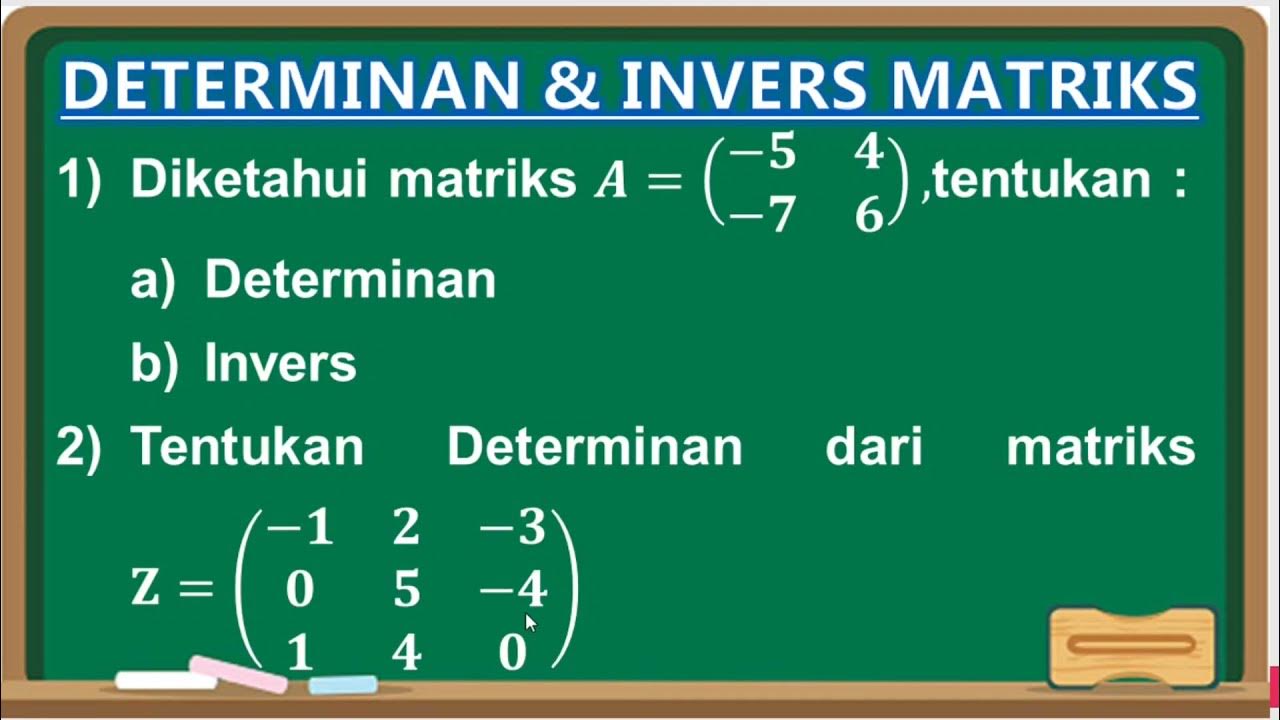Matriks Matematika Wajib Kelas 11 - Minor, Kofaktor dan Adjoin Matriks Ordo 3x3
Summary
TLDRIn this tutorial, Deni Handayani explains how to calculate the minor, cofactor, and adjoint of a 3x3 matrix, which are essential concepts for understanding matrix inversion. The video provides step-by-step instructions and examples to help viewers grasp the process, from determining minors for each matrix element to calculating the corresponding cofactors. Finally, the cofactor matrix is transposed to find the adjoint, which is crucial for future calculations of matrix inverses. The video concludes with a practice problem to solidify the learned concepts.
Takeaways
- 😀 The video explains how to calculate the minor, cofactor, and adjoint of a 3x3 matrix, which are essential for finding the inverse of a matrix.
- 😀 Minor of a matrix element is the determinant of the 2x2 matrix formed by removing the row and column of that element.
- 😀 To calculate the minor of an element, identify the remaining elements after removing the corresponding row and column and then compute the determinant.
- 😀 After finding the minors of all elements in a matrix, the next step is to calculate the cofactors, where each minor is assigned a sign based on its position.
- 😀 The signs for the cofactors alternate in a checkerboard pattern, starting with a positive sign in the top-left corner.
- 😀 Cofactors are derived by applying the sign rule to the minors, producing a matrix called the cofactor matrix.
- 😀 To find the adjoint of a matrix, take the transpose of the cofactor matrix. This involves swapping rows and columns.
- 😀 The adjoint of a matrix is crucial for calculating the matrix inverse, as the inverse is the adjoint divided by the determinant.
- 😀 The example in the video demonstrates how to compute the minor, cofactor, and adjoint for a given 3x3 matrix step by step.
- 😀 Viewers are encouraged to practice on their own by calculating the adjoint of a given matrix as an exercise before moving on to the inverse calculation.
- 😀 The process of finding the adjoint is essential for solving problems related to matrix inverses in further lessons.
Q & A
What is the focus of this video?
-The video focuses on teaching how to calculate the minor, cofactor, and adjoint of a 3x3 matrix, which is essential for calculating the inverse of a matrix.
Why is understanding minors, cofactors, and adjoints important?
-Understanding minors, cofactors, and adjoints is crucial because they are the foundational steps in calculating the inverse of a 3x3 matrix.
What is the first step in calculating the minor of a matrix element?
-The first step in calculating the minor of a matrix element is to remove the row and column of the element you are focusing on and then calculate the determinant of the remaining 2x2 matrix.
How is the minor of the element at position (1,1) calculated in the given matrix?
-To calculate the minor of element (1,1), you exclude the first row and first column, leaving the matrix [[5, 1], [4, 2]]. The determinant of this 2x2 matrix is 10 - 4 = 6.
What is the pattern for assigning signs to the elements when calculating the cofactor matrix?
-The sign pattern for the cofactor matrix alternates between positive and negative in a checkerboard fashion, starting with a positive sign at the top-left element.
What is the difference between a minor and a cofactor?
-A minor is the determinant of the 2x2 matrix obtained after removing a row and column from the original matrix. A cofactor is the minor multiplied by a sign that alternates in a checkerboard pattern.
How do you calculate the adjoint of a matrix?
-To calculate the adjoint of a matrix, you first find the cofactor matrix, then take the transpose of that cofactor matrix.
What is the result of transposing the cofactor matrix of a 3x3 matrix?
-The result of transposing the cofactor matrix is the adjoint of the matrix, which is used in the calculation of the inverse.
Can you explain how to compute the cofactor for element (2,1)?
-To calculate the cofactor for element (2,1), you remove the second row and first column, leaving the matrix [[3, 4], [2, 4]]. The determinant is 12 - 8 = 4. The cofactor is then multiplied by -1 due to its position in the sign pattern.
How does the pattern for cofactor signs change with larger matrices (e.g., 4x4 or 5x5)?
-For larger matrices, the sign pattern alternates in the same checkerboard style, but the size of the matrix determines the complexity of the cofactor matrix.
Outlines

Этот раздел доступен только подписчикам платных тарифов. Пожалуйста, перейдите на платный тариф для доступа.
Перейти на платный тарифMindmap

Этот раздел доступен только подписчикам платных тарифов. Пожалуйста, перейдите на платный тариф для доступа.
Перейти на платный тарифKeywords

Этот раздел доступен только подписчикам платных тарифов. Пожалуйста, перейдите на платный тариф для доступа.
Перейти на платный тарифHighlights

Этот раздел доступен только подписчикам платных тарифов. Пожалуйста, перейдите на платный тариф для доступа.
Перейти на платный тарифTranscripts

Этот раздел доступен только подписчикам платных тарифов. Пожалуйста, перейдите на платный тариф для доступа.
Перейти на платный тарифПосмотреть больше похожих видео

Matriks Matematika Wajib Kelas 11 - Invers Matriks Ordo 2x2 dan Ordo 3x3 dan Sifat-sifatnya

Cara Menentukan Determinan dan Invers Matriks

Matrices - Minors and Cofactors | Don't Memorise

MATRIKS RUANG VEKTOR | MENCARI DETERMINAN DENGAN METODE OBE

Matriks Matematika Wajib Kelas 11 Bagian 2 - Operasi Matriks

INVERS MATRIKS ORDO 2x2
5.0 / 5 (0 votes)
